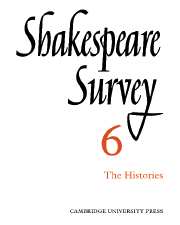Book contents
- Frontmatter
- Shakespeare's History plays: 1900-1951
- The Unity of 2 Henry IV
- Anticipation and Foreboding in Shakespeare’s Early Histories
- Middle-Class Attitudes in Shakespeare’s Histories
- A Reconsideration of Edward III
- On Producing Henry VI
- The Huntington Library
- An Early Elizabethan Playhouse
- Shakespeare Learns the Value of Money: The Dramatist at Work on Timon of Athens
- Shakespeare’s French Fruits
- An Elizabethan Eyewitness of Antony and Cleopatra?
- Othello’s “It is the cause . . .”: An Analysis
- On Translating Hamlet
- Shakespeare in China
- International Notes
- Shakespeare Productions in the United Kingdom: 1951
- Shakespeare’s History Plays - Epic or Drama?
- Festival Shakespeare in the West End
- The Year's Contributions to Shakespearian Study 1 Critical Studies
- 2 Shakespeare’s Life, Times and Stage
- 3 Textual Studies
- Books Received
- Index
- Plate Section
The Year's Contributions to Shakespearian Study 1 - Critical Studies
Published online by Cambridge University Press: 28 March 2007
- Frontmatter
- Shakespeare's History plays: 1900-1951
- The Unity of 2 Henry IV
- Anticipation and Foreboding in Shakespeare’s Early Histories
- Middle-Class Attitudes in Shakespeare’s Histories
- A Reconsideration of Edward III
- On Producing Henry VI
- The Huntington Library
- An Early Elizabethan Playhouse
- Shakespeare Learns the Value of Money: The Dramatist at Work on Timon of Athens
- Shakespeare’s French Fruits
- An Elizabethan Eyewitness of Antony and Cleopatra?
- Othello’s “It is the cause . . .”: An Analysis
- On Translating Hamlet
- Shakespeare in China
- International Notes
- Shakespeare Productions in the United Kingdom: 1951
- Shakespeare’s History Plays - Epic or Drama?
- Festival Shakespeare in the West End
- The Year's Contributions to Shakespearian Study 1 Critical Studies
- 2 Shakespeare’s Life, Times and Stage
- 3 Textual Studies
- Books Received
- Index
- Plate Section
Summary
“And is there a difference between the various years?” asked Hjalmer Ekdal. The answer is undoubtedly yes. In spite of the really alarming growth in Shakespearian studies—there is a book or article on Shakespeare for every day of the year—every year has a characteristic flavour. In Shakespeare Survey, 1, Miss Ellis-Fermor observed “the contemplation of Shakespeare as an artist and as a poet”, and she looked for a crucial change in the direction of criticism within the next few years. The next year she laid the emphasis upon the development of Shakespeare’s art and thought, and in Shakespeare Survey, 3 she said:
The contributions of the last three years make two things clear: first that the stream of general studies is setting steadily in the direction of interpretation and . . . second, that the increasing tendency (at the time of writing) is to a close and, when necessary, an abstract habit of thought which nevertheless acknowledges the fundamentally unabstract nature of dramatic art.
(p.137)The critical studies of 1951 bear out these views. Shakespeare the artist and poet is the subject of the majority of works, and Shakespeare is interpreted in terms of speech and style. The language of the plays looks like being the central interest for some years to come. As in the 1920's Shakespearian study depended upon an increased awareness of the power of theatrical conditions, and in the 193 o's was concerned chiefly with problems of imagery, so the writers of to-day are instinctively looking for poetic and dramatic patterns, but with a closer sense than the critics of the 193 o's employed of the way in which these were shaped by Elizabethan habits of thought and of writing.
- Type
- Chapter
- Information
- Shakespeare Survey , pp. 147 - 154Publisher: Cambridge University PressPrint publication year: 1953

